Sometimes referred to as a game camera, the best trail cameras are essential pieces of kit for travelers with a sense of adventure and those who live in rural areas.
Designed to take snapshots or video footage in territories where a photographer cannot and does not stand (or, let’s be honest here, to snap selfies – we live in the 21st Century after all), trail cameras are complex pieces of machinery that spring into action based on movement.
Contents
If you are on a safari or hunting holiday, a trail camera can be invaluable to capturing those all-important memories.
Hang the gadget safely from a static position such as a tree or car window and marvel as roaming wildlife is immortalized on film, creating cherished memories that you can refer back to time and again.
The same goes for keen nature lovers who are curious about what animalistic visitors approach their homes while not being watched – a trail camera can snap birds, deer and whatever else may appear.
Live in hunting territory? Dot a number of these cameras around your property and you can get an idea of just how much game is roaming, and where. You can even use such a device for home security in lieu of CCTV.
Intrigued by the concept of a trail camera? Then read on, as this guide will talk you through the often overwhelming experience of choosing an appropriate model, discussing the many and varied features, price points and functionality of these devices, and making recommendations based on your needs.
Best Trail Cameras Below $100
Looking for a low-cost model when it comes to trail cameras isn’t necessarily the worst idea – the more expensive models may come with increased bells and whistles, but that could point to technology that has yet to be perfected.
If you’re looking for something basic but functional, these are ideal starter models. Take your time when investigating the different models, choosing the wrong one could prove costly in the end.
Crenova Game and Trail Camera
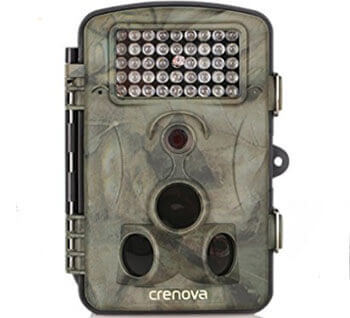
Capturing 5 megapixel HD photos – which can be set to be snapped at certain times of day – from a range of up to fifty feet and running for an impressive period from eight AA batteries, the Crenova Game and Trail Camera is a great introduction to this realm.
The camera runs virtually silently, and the flash – whilst not utilizing black flash technology – is comparatively dim and subtle (albeit undoubtedly noticeable to the human eye – this is not a camera to use for private home security).
The only downsides are the trigger speed, which often runs a little slower than the solitary second advertised, and the sensitivity of the trigger; invest in a large SD card, because you may have number of wasted shots when the camera picks up a gust of wind and mistakes it for the movement of a living creature.
Overall, however, this is a great piece of no-frills kit for the price point.
PROS – Clear and bright photos, especially for the price point, and extremely easy to set up right out of the box. This is also a sturdy unit that will not fall to pieces in adverse weather conditions.
CONS – The trigger speed of this camera is not really at the top end, which will be frustrating for some users, and the movement sensor can be a little sensitive; you may have to wade through a number of snapshots of nothing in particular to get to what you need as the wind has activated the camera.
TEC.BEAN Game and Trail Hunting Camera
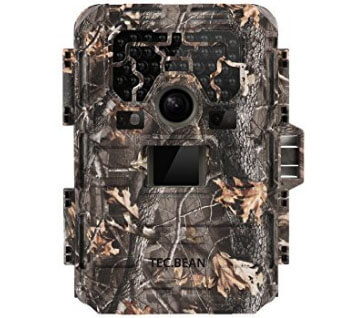
Discretion is often the name of the game with a trail camera, and the TEC.BEAN has that down to a fine art.
Aesthetically camouflaged and running quietly with a low-key black flash, the TEC.BEAN has a shutter speed of less than a second and can be set to snap at timed intervals, capturing photos at up to 8 megapixels, although it should be noted that the night shooting is significantly less clear and impressive than the daylight equivalent.
Being a budget model there is no external connectivity with the internet or a smartphone, but the TEC.BEAN certainly has a number of uses as a small, starter model or for those looking for something almost invisible.
PROS – Easy to set up from the box and very discrete, the TEC.BEAN will nestle neatly into woodland and not give away its position. Utterly waterproof, so it can be left out in a storm with no drop in quality.
CONS – The picture and video quality is fine by day, but quite grainy when it comes to night shooting – if you’re using your camera after dark, this may not be ideal. The screen is quite small as a result of the device’s subtlety, and the TEC.BEAN eats batteries at a rate of knots.
Best Trail Cameras Below $150
Moving up a notch on the price totem, you may discover that a little extra goes a long way in terms of trail cameras. Here are two models well worth looking into if you can spare three figures in your budget.
TRACE Premise Surveillance Camera
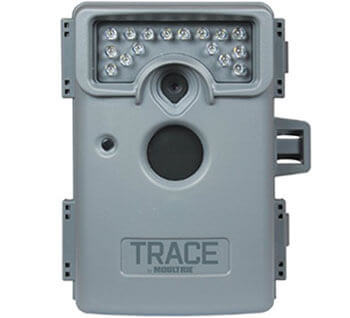
TRACE stands for Tactical Recording and Capture Equipment, which should give you some assurance that this unite specializes in your needs – especially when we consider that it is manufactured by industry leaders Moultrie.
The Premise Surveillance Camera suffers from a very narrow field of vision after dark, but is otherwise a fantastic piece of kit – snapping images at a rapid pace and recording video in eye-saucering HD, the TRACE is fully programmable for timed bursts of use and picks up movement from infra-red radiation, meaning any warm body will do the trick without the risk of filming the wind.
PROS – Easy to fix up and boasting a fast operating trigger speed and long battery life, this is a strong all-rounder for daylight hours.
CONS – This camera has a pretty low field of vision at night, only reliably activating when it picks something up from ten feet or less. No black flash mode either, meaning that as far as overnight home security goes it may be something of a non-starter.
Wild-Vision Full HD 5.0 Trail and Game Camera

Something of a masterpiece of German efficiency in its engineering, it’s hard to look past the Wild-Vision as a starter model.
Packaged to be used from the box, right down to the fact that batteries are included, this camera boasts a vision range of 65 feet, fast trigger responses, black flash technology and HD images that can be set as high as 12 megapixels, it’s difficult find fault with this product for the price point it’s offered at.
PROS – Great images, waterproof, can run from 4 batteries as opposed to 8, packaged with a memory card and batteries, easy to set up, find long-distance motion sensors… you could go on. This is possibly the best value camera on the market.
CONS – The customer service telephone line and website are German-speaking. That’s literally the only fault we can find for this price range.
Best Trail Cameras Below $250
Another nudge up the costing ranks, and now you’ll really be playing with power. You should be able to really see where your money is going with one of these excellent devices.
Day 6 Plotwatcher Pro HD Game Surveillance System
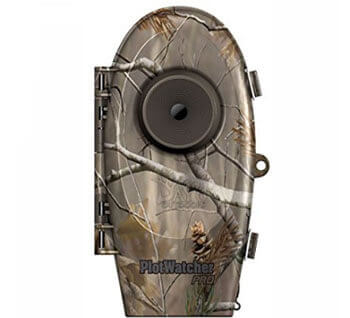
This model takes an interesting and new approach to snapping game, not operating on motion detection but instead taking shots at regular intervals – these can be set and personalized by the user to be every 5-10 seconds.
This may sound like a whole lot of wasted camera memory, but the Day 6 Plotwatcher Pro converts the activity in a 10-minute time-lapse montage for you, giving you an idea of where and when you are enjoying visitors without trawling through dozens of photos activated by a breeze.
With this alternative mode of operation in mind, this camera can capture images from over 300 feet away!
PROS – By far the longest range of capture of any camera on the market, and the regular shooting as opposed to motion detection is a useful way of investigating nocturnal activity. Great battery life, too.
CONS – This camera does not film video, just creates one based on the photographs that it captures – some users may prefer the opportunity to have both features. It’s also not the simplest set-up from the box, and other cameras can boast better image quality.
Spypoint Solar Trail 12MP Camera
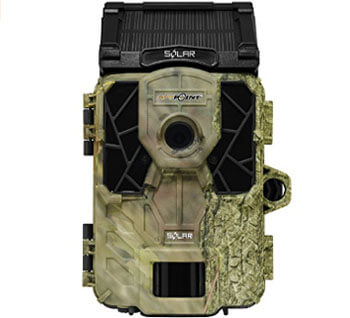
There’s been a lot of talk of battery life on this guide, so here’s something a little different – a trail camera that runs from solar power.
Once fully charged you can expect to get around six weeks of use from the Spypoint, regardless of whether it’s been exposed to overcast or dreary weather conditions, and the 12 megapixel camera captures some impressive snapshots during the day – alas, as is a common complaint with game cameras, the night shots are not quite up to the same standard.
Easy to set up, lightning-fast trigger response and a motion sensor of up to eighty feet makes for an impressive package all around.
PROS – The solar power of the Spypoint is more than a sales gimmick – it’ll save you a lot of money and hassle in replacing batteries. The picture quality is also very striking during daylight hours, and the fast reaction and time and vast range is impressive.
CONS – The photos and video taken by night are very blurry by comparison; it’ll do the job as an all-rounder, but there are better options for use as either security cams or hunting guides. The camera also emits a low red glow when snapping.
Best High-Cost Trail Cameras
In the spirit of full disclosure, you really shouldn’t need to spend this much money on a trail camera unless you are at least semi-professional as a photographer. If money is truly no object, though, you can do far worse than either of these options.
Spartan HD GoCam 3G Wireless
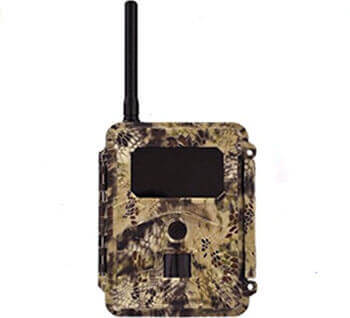
Compatible with a cellphone to be used as photo management software, the Spartan HD GoCam is not cheap at a touch under $400 (as of 20th May 2017), but it certainly offers a plentiful supply of extra features for your money.
You can use the camera from the moment you unbox it, which is always a bonus, and the battery life is impressive.
The camera captures images and video based on motion from a distance of up to 70 feet, shooting photos up to 8 megapixels and video up to 720p.
Happily, the Spartan HD works just as well when night shooting as it does during the day, preventing frustration from blurred and unclear images following overnight incidents.
PROS – An expensive but solid all-round camera, the Spartan HD will not let you down with clear images and video, day or night. The ability to manage the camera remotely is also a welcome
CONS – East to set up and solid performing the camera may be, but you are still ultimately paying a significant sum for cell phone interactivity. Do you really need that, or could you look into a cheaper model?
Reconyx HyperFire Infrared Digital Game Camera HC600
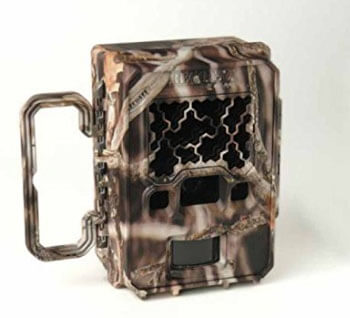
$550 ought to buy you a whole lot of quality in your camera, and it certainly does in the case of the Reconyx HyperFire.
First thing’s first – this model does not shoot video, which may seem utterly bizarre for something so expensive.
However, this American-made device is a tough little so-and-so and will almost certainly outlast any other model on the market – and if it doesn’t, Reconyx will fix or replace it, even if it’s out of warranty.
Truly a case of buy once, pay once. The camera also has a range of up to 60 feet, a shutter speed of two frames per second in glorious HD, a subtle black flash, excellent battery life and compatibility with Windows computers.
PROS – In terms of reliability and pure performance, nothing can compare to the Reconyx HyperFire. It’s practically bombproof (and any damage or failure in operation will be dealt with in a friendly and efficient manner), the daytime images are crystal clear and few cameras snap at a faster rate.
CONS – A hefty price tag BUT no video feature? Night footage could also be clearer for the money.
Best Trail Camera for Home Security
We have previously focused our attentions on all-around high-performance trail cameras, but if you are more interested in home security over animal photography you can save yourself a few bucks.
Stealth Cam P18 Compact Scouting Camera
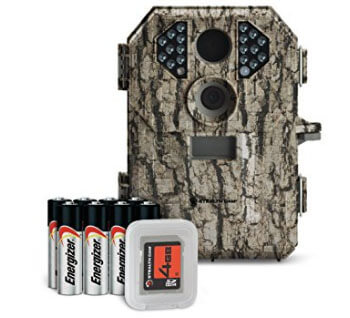
Priced at a little over $100, this camera is small and subtle enough to use to capture images or fifteen seconds of video of home invaders without sacrificing much in the way of picture quality.
Activated by motion sensor, the Stealth can either snap photos or short, silent video so it’s great for capturing evidence, all while running quietly and discreetly enough to avoid attracting the attention of an intruder.
It’s not as strong for use when shooting images of wildlife as rapid-moving targets tend to come out a little blurry, but if you’re concerned about human intrusions onto your property, the Stealth Cam P18 will do a fine job of recording outdoor activity without breaking the bank.
You can also download the images to a computer with minimal fuss should you need a back-up.
PROS – Not too expensive at all, the Stealth Cam manages to capture images of up to 7 megapixels without giving away its whereabouts – packaged with batteries and an SD card, and comparatively simple to set up out of the box.
CONS – This camera is not waterproof, so be sure to locate it somewhere that it’s protected from the elements. You’ll notice a sharp decline in quality of night shots of fast-moving targets, so don’t expect to capture high-end footage of animals in addition to acting as an anti-theft or vandalism security cam.
Best Trail Camera for Hunting
And to conclude let’s focus on what many will consider to be the primary function of a trail camera – the ability to scope out and record wildlife activity for hunters.
If you’re only concerned with dealing with the best game camera to aid in your sporting pursuits, common consensus among the hunting community appears to land on one model standing above the rest.
Browning Strike Force Pro Micro Trail Camera
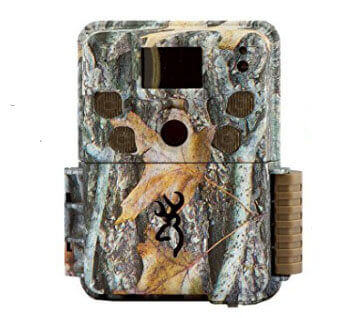
The Browning Strike Force Pro offers everything that a hunter will need to enjoy their purchase of a game camera.
Running for almost a year on just 6 AA batteries, the camera can take photos and videos at a rate of up to 18 megapixels that do not decline sharply in quality at night, picking up a range of up to 20 feet, and it’s simple to set up from the box.
There’s no interactivity with other devices, but that’s par for the course at this price point. Keen hunters may well wish to invest in several of the same cameras to locate around their periphery, and the Browning Strike Force Pro is a fine investment to duplicate.
PROS – The battery life is phenomenal and unmatched by any other model on the market, and the quality of night shooting is very welcome. 20 feet is a string range for activating the motion detection, and at a comparatively low cost for such a find product, it’ll be tempting to pick up multiple versions of this same model.
CONS – The infrared does give off a very faint red glow; it’s subtle, but it might still be enough to put some off, and it certainly won’t work as a human deterrent security cam for this reason.
Buyers Guide to Trail Cameras
So, you’ve decided that you need a trail camera in your life. What should you be looking for in such a purchase?
There are 7 core areas that you should look into when researching whether a trail camera is right for you.
Detection Software
How well will the camera detect movement, and from what distance?
Trigger speed is particularly important if you are hoping to capture images of wildlife that moves at haste, or for any kind of home security detail.
Always check the distance that a camera will pick up an image from, and how quickly it will take action when it does pick up a life sign from afar.
Battery Life
Trail cameras run from external batteries, so you’ll want to know how long they’ll last.
Not only will a camera that burns through batteries frustrate you as you’ll have to regularly change them (which will be increasingly frustrating if they run out during the evening when you are not monitoring the camera), but it’ll end up costing you a small fortune in power unless you use rechargables.
Flash & Infrared
Does the camera run with an automatic flash or infrared dot that will spook wildlife, or give away the location of your trail camera? That’s a real weakness when it comes to security, and ideally you’ll want something subtle.
To this end, a camera with black flash technology is a worthy consideration. This new development in tracking photography sometimes increases the price of a model, but will also prevent anybody or anything knowing exactly where your camera may be housed.
Screen Size
Like all digital cameras, a trail camera will provide a viewing screen for sizing up and previewing shots.
Have a think about how large you’d like this to be, and look into how user-friendly the interface appears to be.
There’s little point investing heavily in a high-end trail camera only to find that you can’t decipher most of the features.
Picture Quality
Cameras obviously live and die by their picture quality, which is measured in megapixels.
In theory, the more of these the clearer the image, but this is not an exact science – investigate the sample images provided by a seller rather than blindly chasing the megapixel rate, as sometimes you may be surprised by the discrepancy.
Extras
Is the camera Wi-Fi compatible, and will it work in tandem with your computer or smartphone?
Perhaps more importantly, does it need an active connection to another device to function?
You may find yourself somewhere with limited access to such modern wonders.
Question if the extra features found on a costlier model are actually necessary for what you plan to use the camera for, or if they are just nice to have.
Price
Trail cameras vary in price (and, of course, quality), with costs beginning in double figures and stretching very significantly.
We will break down our recommendations into usage and different price points, but it may be beneficial to think about a budget before you start your research.
What Do You Plan To Use It For?
Of course, there is also the small matter of what you actually plan to use the camera for.
A gadget that is designed for hunting or wildlife observation may not prove to be as useful when used as a security device.
The optional extras that come with some cameras will also be a factor.
We could go on, but let’s get to the point – above you’ll find recommendations of ten different best trail cameras that fall under a number of different criteria that will help you find the model that best serves your needs and circumstances.
